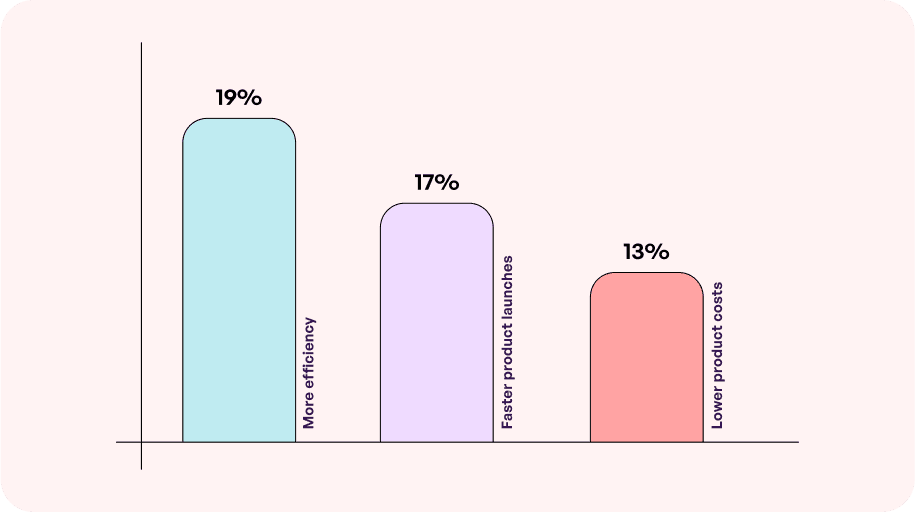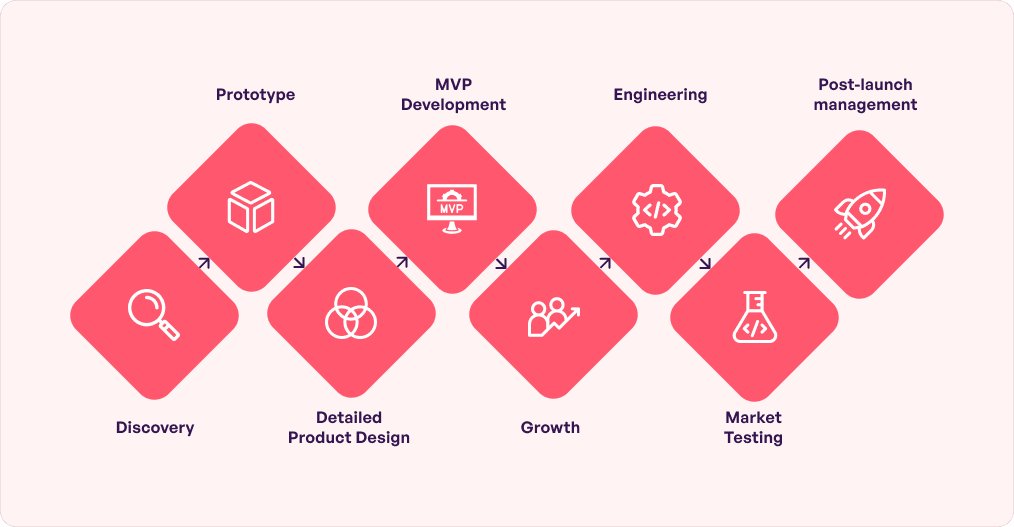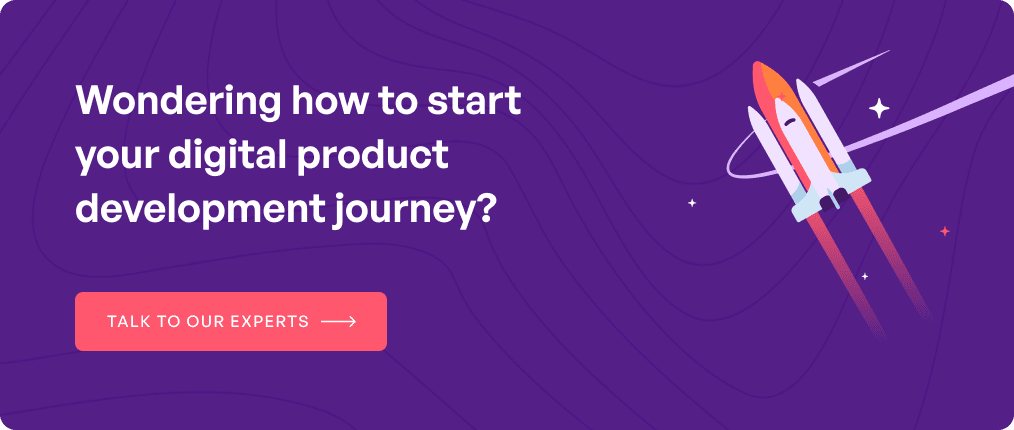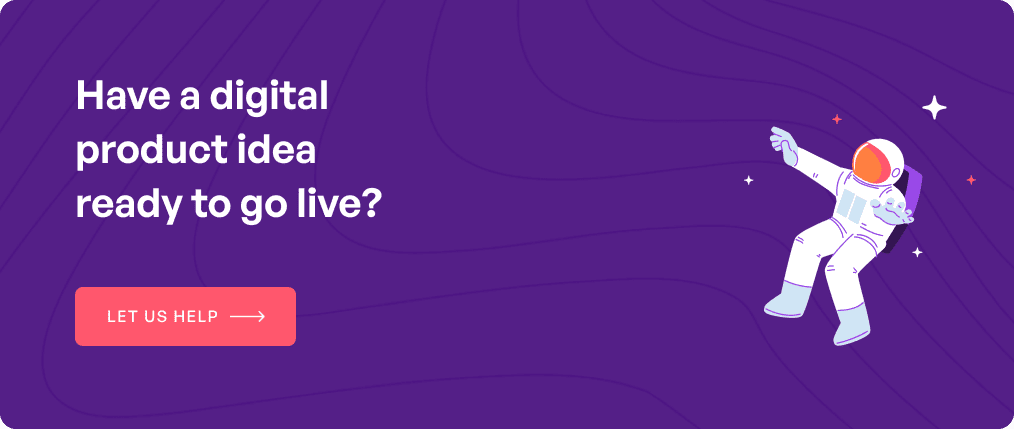In the era of uber digitalization, the focus of consumers and businesses alike have shifted to value. This means users have made their stance clear that they wish to stick with companies that offer maximum value for their money and time. On the other end, businesses, across domains, are finding themselves in the middle of a customer-first mode of operation – a way of survival that requires them to consistently deliver high value through their digital products. This is when a well-established and well-curated digital product development process comes into the picture. Its importance has grown significantly over the years. Here’s proof. The global digital transformation market stands at $791.4 billion in 2024 and is expected to touch $2,639.4 billion by 2034. Let us understand what digital product design and development is all about.
Table of contents
What is meant by a digital product development project?
The concept of digital product design and development revolves around building a software solution or application to be used by a digital audience and would have a positive impact on the business operations. By positive impact, it means expanding the customer base globally, enhanced data collection, strong resource management, and ensuring better engagement with music and custom templates with digitalproduct transformation. The digital product development life cycle is typically structured around 4 stages:
- Introduction – When the product is launched in the market.
- Growth – This is when the product is gaining traction and is being used by customers.
- Height– At this point, the product has maximized its potential and reaches maturity.
- Downfall – The product has lost its popularity and relevance among users.
Further, if you look under the ‘digital hood’, building digital solutions ensures better profit margins. A Harvard Business Review report found that 89% of big companies across the world with digital and AI transformation in progress have already captured 31% of the expected revenue lift.
For a simpler understanding of the concept, think of any digital solutions you interacted with recently, maybe a messaging platform like WhatsApp or an HRM software. For this, digital product developers improve the overall customer journey by creating sophisticated and intricate interfaces that promise digital-first market offerings.
To gain a definite understanding into the expectation that companies have from digital product development, a PWC report came in where 200 industrial companies were surveyed and they revealed that they expected their digital solutions to bring in 19% average rise in efficiency. Other expectations are lower production costs and expedite the go-to-market time with positive customer experience being a by-product.
 In order to design and engineer a “preferred platform” that helps consumers and businesses alike, a well-curated set of digital product development stages is required. It helps deliver consistent value to customers while simultaneously staying within the budget and executing each stage systematically and error-free. Now, a digital product life cycle is exactly what we are going to discuss in detail today.
In order to design and engineer a “preferred platform” that helps consumers and businesses alike, a well-curated set of digital product development stages is required. It helps deliver consistent value to customers while simultaneously staying within the budget and executing each stage systematically and error-free. Now, a digital product life cycle is exactly what we are going to discuss in detail today.
8 phases of digital product design and development process
The intent behind digital product development services is usually different. While some businesses are looking for an enterprise-grade SaaS solution, others might be looking to build an OTT platform. However different the product ideas be, the digital product development process is more or less consistent. They typically vary in terms of product strategy and development process. Let us look into them.

Discovery
Discovery is probably one of the most critical, yet often overlooked digital product development stages. It is an extensive process of knowing your end-user and identifying problems worth solving. The reason businesses often overlook this step is because they either think they know the industry too well or are too married to their idea.
If you, as an entrepreneur, don’t fall into either category and are starting fresh, these are the ways to tackle the discovery stage to find new product ideas.
- Find ideas around you – Businesses like Airbnb and Uber were formed at the back of a necessity. As a prospective entrepreneur, you should always be on the lookout for problems that a majority of people around you are facing and then try to find a marketable digital solution for it. Do not forget the goals and scope of turning your idea into reality for an informed choice.
- Improve existing product – Oftentimes we take inspiration from a product that already exists and think of ways how we would have done it differently – it could be on price point, a new feature, or simply an automation of the core service offering.
- Research trends – Emerging trends like veganism, generative AI, traceability in the supply chain, etc. can give you a headstart into the business vertical you should focus your digital product development efforts in.
Once you have gathered a few ideas at the back of these discovery modes, validate them against market, technological, and customers’ willingness to pay.
Prototype
With the product now validated, the next digital product design and development stage that comes is creating a prototype of the product which can be used for gathering the initial reaction and acceptance.
The prototype helps establish answers to the following questions before the actual digital product design process starts.
- What is the need for the digital product?
- What will the customers and businesses achieve from the product usage?
- Who will use the product?
- How will the digital product solve users’ problems?
Detailed product design
At this digital product development process stage, a detailed design of the product is made with interactive elements to give stakeholders a detailed understanding of what the product will look and feel like when the end users will work on it. This stage relies on multiple brainstorming in terms of testing, building, imaging, and modifications. It helps digital product developers create a highly user-centric design by having a clear idea of industry-specific user needs and their potential solutions. In short, the intent at this stage is to build a version that the developers will work on to make the final digital product.
An effective digital product design process usually follow these steps –
- Specification of design elements and user movements
- Creation of wireframes
- Developing high-fidelity prototypes
- Usability testing to ensure that the design meets users needs.
Explore how we follow these steps to design an immersive product by visiting our DesignRush profile.
Engineering
One of the following SDLC methodologies will be used to complete the digital product development stages:
Agile – It is a collaborative approach between your requirements and the product development team. The project is broken down into multiple stages to offer value to clients in small and systematic installments for high-end satisfaction.
DevOps – This SDLC method focuses on automation and continuous feedback with a well-structured and step-by-step approach. Although the delivery batch size is small, it is a fast-moving process.
Other digital product development frameworks include Lean, Waterfall, Iterative, and Spiral methodologies.
Market testing
Digital products typically go through Alpha and Beta testing of the ‘candidate version.’ This is done with real end users and ‘exit data’ is collected. This includes covering issues or opportunities of the product and taking actions on them. When everything is working as expected, bugs and errors are fixed and all user feedback is ticked off, the digital solution is completely ready for launch.
MVP development
Once the designers hand off the design to the developers, the MVP creation phase starts. This is a crucial stage of the digital product development framework since the minimum viable version of the product is built here. It is done with a basic set of core features to test the acceptance among real users.
The reason why a majority of entrepreneurs opt for MVP instead of full-fledged product development is because the former get them access to customer feedback before they have invested heavily in the end-to-end product development cycle. Moreover, it acts as a collateral for sharing with the investors.
A critical part of the MVP phase of digital product development life cycle lies in choosing the best launch strategy. Typically, you get two options here.
- Soft launch – MVP is launched among a limited segment of target market.
- Hard launch – MVP is made available to the entire market with a heavy marketing push.
Reading powerful case studies can help you gain a clear understanding of how software applications like mobile apps and similar platforms work. For instance, following a streamlined approach and digital product development lifecycle helped us create Tavus, our AI-powered video personalization platform. It is a clear example of how our digital product development company aced it seamlessly.
Growth
After you have gone through the entire digital product development process and have built the MVP, the next stage that comes is growth. Here, the feedback which you must have gathered after the MVP launch is integrated in the digital product development life cycle along with new feature additions and tech integrations.
At this stage itself the digital product transformation strategy is also set up which defines the optimal product price, the marketing strategy, and how businesses will approach continuous updation and delivery. Overall, this digital product development process is meant to decide on the long-term success of the product. Consumers begin to start taking actions, that is, buy the product, it becomes popular and the revenue increases.
Post launch management
In this stage, developers monitor cross-platform product performance closely. This helps them update, optimize and enhance the product for better market acceptance. The post launch testing process also involves a bug detection and rectification phase for smooth functionalities.
These seven-parts digital product development stages often see additions in the form of extra steps like validation of the idea, digital product testing, and a separate market research and analysis phase. However, at Simublade, we club certain closely related phases together so that new entrepreneurs don’t get overwhelmed with the number of stages or overall digital product management process when they have just initiated their digital journey.
 The team of experts strive to increase the chances of market acceptance and help companies become digital-first. Be it business mobile applications or web solutions, they make sure the end-result of the digital product design process is scalable and fail-proof.
The team of experts strive to increase the chances of market acceptance and help companies become digital-first. Be it business mobile applications or web solutions, they make sure the end-result of the digital product design process is scalable and fail-proof.
As you dive into these digital product design processes, it is critical to keep a look out for some commonly occuring challenges in the journey. Let us look at some of them at a high level so that you can ensure that the digital product development services you have invested in have a profitable outcome.
Benefits of digital product development
There are plenty of advantages of considering a well-strategized digital product development cycle. It is a fruitful investment for the following reasons:
- Testing and refining products means better risk mitigation.
- Continuous upgrades to stay ahead of the curve.
- Ability to meet ever-changing demands without incurring significant expenses.
- Digital distribution of the product can transcend geographical borders.
- Production is typically done on demand which reduces inventory costs.
Fewer chances of failures is another big advantage since a clear lifecycle can help rectify even the tiniest bug. Altogether, it is a holistic way of digital product transformation that helps meet customers’ changing demands. This in turn boosts satisfaction and retention.
Technologies and tools that help in successful digital product development lifecycle
Blockchain, IoT, and artificial intelligence are the core technologies used. We at Simublade, are proficient in each one of them and can ensure a secure, transparent, and cost-effective product development process for both startups and enterprises.
Besides the tech stack, tools like Adobe XD and Sketch are popular tools for seamless and high-functioning product development.
A mix of both can offer the much required edge over competitors while helping you stand out in the digital crowd.
Commonly occurring digital product development services challenges
Building a digital product can be complex and entangled with challenges that come to the surface when entrepreneurs are not careful. Some of those roadblocks are –
- Absence of detailed market research – A lack of competitor, user, and general market research can lead up to a situation where businesses don’t have a clarity on what the world really needs and if their digital product is aligned with that requirement.
- Budget limitations – Building an innovative feature-rich digital product comes at a cost, something that new entrepreneurs find challenging to accumulate. Get an idea of the costs of production, development timeline, features, programming level, design iteration numbers, and quality of the final digital solution. These will help you quote a fair budget.
- Limited technical expertise – Entrepreneurs rarely have the complete technical expertise to build a digital product that uses the right blend of technology and digital product development framework to create a scalable product. To solve this, they often turn to a digital product development company.
- Ensuring digital security – The digital space is laced with cybersecurity and hacks issues. It can get complex to build a digital product which is completely hack-proof without any prior experience in cybersecurity.
Solving all these challenges while ensuring timely go-to-market is something that typically keeps entrepreneurs from entering this journey in the first place and is exactly what we wish to solve at Simublade.
We have helped a number of businesses set their digital product development journey off the ground by assisting them chart the digital product strategy, followed by the design, development, and scaling of the final product version.
Recently we worked with Caristas, a car selling company who wanted to take the car sale and purchase journey online through a web and mobile app. We helped them with the end-to-end product development journey starting with the scope definition through extensive market research – something that highlighted the need for integrating AI based surveys for a smart buying choice – followed by the product design, and development.
The result? Caritas has established itself as a game-changer in the retail automotive industry in a very short span of time. The project is just one of the many digital products our digital product development company has built and deployed.
 Digital product development journey can be complex, however we can make the process easier with our dedicated expertise that ranges from idea validation, design, to development, and scaling of the product. Get in touch with our team of product development experts, today.
Digital product development journey can be complex, however we can make the process easier with our dedicated expertise that ranges from idea validation, design, to development, and scaling of the product. Get in touch with our team of product development experts, today.
FAQs
Q. What is digital product development?
Ans. Digital product development is the process of building software solutions, applications, and other platforms that are a part of the digital product ecosystem.
Q. What is the digital product development process?
Ans.The digital product development process comprises following stages – product discovery, prototype creation, UI/UX design, MVP development, and post-launch growth.
Q. What is the digital product life cycle?
Ans. The digital product life cycle is fairly different from the regular product development life cycle that comprises introduction, growth, maturity, and decline. The digital product life cycle is made of stages like product strategy, product design, product development, and product growth.
Q. What are the benefits of digital product development?
Ans. A digital product gives businesses a wide span of benefits spanning from better operational efficiency, lowered market time, reduced production costs, and ultimately an image of being a customer-first company.
Q.What are the digital product development mistakes to avoid?
Ans. Not considering the digital product development lifecycle is the biggest mistake that you, as a company, can do. So, get in touch with qualified developers, like the ones at Simublade, who work with minimal errors for the best results.



